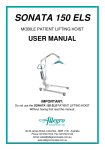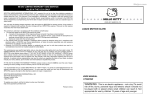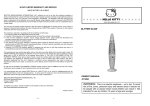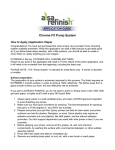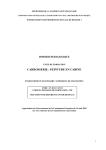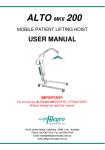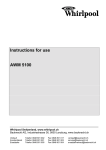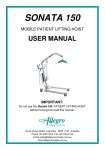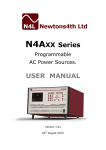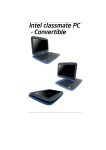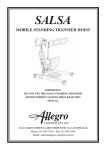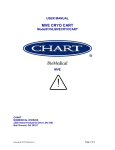Download Allegro Alto Hoist
Transcript
ALTO LIFT 200 MOBILE PATIENT LIFTING HOIST USER MANUAL IMPORTANT: DO NOT USE THE ALTO LIFT PATIENT LIFTING HOIST WITHOUT HAVING FIRST READ THIS MANUAL. 30-32 JAMES STREET, LIDCOMBE NSW 2141 AUSTRALIA Phone: 02 9749 7812 • Fax: 02 9749 2144 Email: [email protected] CONTENTS ALTO LIFT 200 OVERVIEW 1 IMPORTANT SAFETY CONSIDERATIONS 2 ALTO LIFT 200 ASSEMBLY INSTRUCTIONS 4 HOIST OPERATION AND CHARGING 5 LIFTING PROCEDURES 9 MAINTENANCE 11 TROUBLE SHOOTING 12 SPECIFICATIONS 13 WARRANTY 14 SLINGS 15 KEY TO SYMBOLS 16 PARTS LIST AND DESCRIPTION 17 LOG BOOK 18-21 ALTO LIFT 200 OVERVIEW The ALTO LIFT 200 is a medium sized heavy duty mobile patient lifting hoist with a safe working load of 200 kg and a compact ergonomic design. This lifter is ideally suited for institutional use or as a compact heavy duty home care hoist for the bariatric patient. The ALTO LIFT 200 whilst being compact, provides superior patient space through the use of SPACE LINK™ technology. The ALTO LIFT 200 IN FACT OFFERS MORE PATIENT SPACE THAN MOST OTHER LARGER SIZE LIFTERS. The unique feature of SPACE LINK™ allows a patient to be rotated through 360° at full lift height and makes the carers job easier and safer. The ALTO LIFT 200 lifting range, allowing patients to be lifted from floor, bed or chair with ease and safety. The ALTO LIFT 200 is a powered unit incorporating trusted industry leading LINAK components, giving a safe working load (SWL) of 200kg. OPTIONS AVAILABLE WITH THE ALTO LIFT 200 Standard padded spreader bar. ALLEGRO Pivot Frame. Tri Hook yoke. Four point yoke. Weighing device. The Allegro Concepts range of patient lifting equipment including lifters, slings and accessories has been designed and tested in house to comply with: AS ISO 10535 – 2002 Hoists for the transfer of disabled persons – Requirements and test methods. 1 IMPORTANT SAFETY CONSIDERATIONS INTENDED USE OF THE PRODUCT The ALTO LIFT 200 compact mobile patient lifting hoist has been designed to lift and transfer a less able person with the assistance of a carer. The ALTO LIFT 200 should be used with one of the ALLEGRO range of patient slings, as assessed by a competent trained person. NB. Not all slings and accessories are compatible with this hoist. If you are unsure please contact ALLEGRO CONCEPTS. The correct and appropriate use of the ALTO LIFT 200 hoist will reduce the risks associated with manual patient handling. The lifting / transferring task should be assessed & planned by a trained user. SAFETY CONSIDERATIONS Ensure that all users read this guide before operating the hoist. Do not operate the hoist without training in the safe operation of hoists & slings. IF IN DOUBT DO NOT USE. Only use slings which have been assessed as suitable by a competent trained professional. Read the relevant sling users guide which is provided with each sling, before use. Do not use the hoist if there is any doubt about wear or damage to the unit. In particular the spreader bar or the ALLEGRO Pivot Frame. Do not use the hoist if there is any fraying or stitch damage to the sling or if the sling is damaged in any other way. DO NOT EXCEED THE SAFE WORKING LOAD OF THE HOIST. SONATA 150KG. ALTOLIFT 200KG. SALSA 200KG. Ensure when the hoist is in use that the surrounding area is clear and the person being lifted is clear of all obstructing objects. 2 JIB MAST PUSH HANDLE ACTUATOR BATTERY & CONTROL BOX BASE CHASSIS LEG 3 PADDED SPREADER BAR ASSEMBLY INSTRUCTIONS SONATA 150 & ALTO LIFT 200 All the ALLEGRO range of patient lifting and transfer hoists are fully assembled, load tested and certified at the factory before being partially dismantled for packing and shipping. Use the instructions below as a guide to assemble your SONATA or ALTO hoist. 1. Remove lifter components from protective packing and lay out on a smooth surface to prevent damage to powder coating on lifter sub assemblies. 2. Lift the mast assembly and slide into mast holder receiving socket on base chassis. Ensure the mast assembly is completetly engaged in the mast socket. Tighten the locking clamp hex bolt to prevent movement between mast and base chassis . 3. Attach lift actuator to jib ,by aligning actuator clevis with actuator mount bracket. Insert bolt and tighten nylock nut. 4. Attach push handle assembly with hex bolts and washers supplied with handle assembly. 5. Insert the leg adjusting handle into the socket of leg adj. pivot mounted on base chassis. Ensure handle key is aligned with cut outs on pivot. 6. Check the operation of the leg adjustment mechanism to ensure the adjuster handle engages the three detent positions with ease of movement. 7. Attach control box to mount plate with M5 hex bolt. Then attach clip on battery pack. 8. Plug the lift actuator cable into port 1 positioned on the underside of the control box, ensuring it is driven firmly home in the socket. 9. If your ALLEGRO hoist uses an electric leg adjustment, plug the leg actuator lead into port 2 n the underside of the control box. 10. Plug the handset lead into the large socket on underside of control box.(diagram 2) ensure alignment of tongue on handset plug with groove in control box handset connection port. when aligned press home firmly. A smear of Vaseline on the o ring may assist if plug is tight. 11. Check operation of lifter via handset , ensuring that the RED EMERGENCY STOP BUTTON ON THE CONTROL BOX IS RELEASED. Turn the knob quarter turn clockwise to release. 4 HOIST OPERATION AND CHARGING HANDSET The handset activates the lift actuator by the use of two low pressure buttons, protected by a strong plastic cover. These are symbolised by arrows (diagram). The arrows indicate the direction of travel to raise or lower the hoist jib. When either button is released the jib will remain in position. Some versions of ALLEGRO hoists incorporate an actuator driven leg opening adjustment. On these hoists two extra buttons will be seen on the handset with arrows and symbolised legs indicating the direction of travel. This function allows an unrestricted range of leg adjustment. The handset is also fitted with a battery indicator light. This will flash when the batteries reach a maximum discharge of 18 volts. NB the light will only flash when the hoist is under load. The connection for the handset is located on the underside of the control box (diagram). 5 ACTUATOR The ALTO LIFT 200 mobile patient lifting hoist uses a LINAK single speed actuator with an emergency controlled lowering release handle.( red lift up tab located at base of actuator shaft). This allows the patient to be lowered in the event of a fault in the hoist or deep discharged batteries. CHARGING The ALTO 200 is fitted with an integrated battery charger, which is activated by plugging the 3 pin plug into a standard 240 volt ac outlet when the lifter is not in use. The charger may be plugged in at any time whilst not in use for top up charging. CHARGING INDICATOR LIGHTS GREEN mains power on light will be illuminated when connected to 240 v power supply. ORANGE LIGHT illuminated indicates battery currently charging. ORANGE LIGHT will extinguish when battery pack is fully charged. 6 ALTO LIFT 200 INTEGRAL CHARGING UNIT 7 CHARGING DOs & DON’Ts DO Do charge the battery whenever possible. This will extend the battery life. A large number of cycles can be obtained from operating on the batteries, but battery lifetime is reduced with frequent discharging. Do inspect all cables particularly the mains power cable on the charger for any damage; replace where necessary. Do stow the handset and if fitted with charger, the mains power cable when transporting the hoist. Do clean the actuators, control box, charger, battery and handset at regular intervals to remove dust and dirt. DON’T Don’t allow the batteries to fully discharge before connecting to charger. The batteries are a lead acid gel type that can be trickle charged continuously and have a high current discharge capacity. The batteries are not the nickel cadmium type and must not be periodically fully discharged. Battery life is greatly reduced by deep or complete discharging of the batteries. Longer lifetime is obtained by maintaining fully charged batteries. 8 LIFTING PROCEDURES • Carer should be fully conversant and trained in the use of lifter and sling. This will decrease patient apprehension and increase their co-operation and overall safety of the lifting process. • Where possible always pull the lifter for maximum safety and comfort. • Move the hoist slowly to avoid patient swing whilst standing. • The hoist should not be used on ramps with incline greater than 5 deg. • Never leave a patient in a sling unattended. • Ensure brakes of the chair, bed, trolley that the patient is being lifted from are locked. • The braking castors on the lifter should be off. This allows the lifter to create its own centre of gravity (C.G,) over the weight of the patient. N,B. This action may result in the lifter moving slightly during the initial phase of the lift. GENERAL LIFTING PROCEDURE The information supplied below is not intended to be construed as a training manual but as a general guide to lifting procedure only. • Fit sling to patient (REFER TO SLING INSTRUCTION FOR USE). • Manoeuvre the hoist around the patient, adjusting the legs to fit around chair , wheel chair etc. If lifting from a bed ensure under bed clearance is sufficient to manoeuvre legs under the bed. • Lower the spreader bar sufficiently to allow fitting of sling attachment loops onto the spreader bar hooks. Ensure spreader bar does not come in contact with patients face or body. • If using the ALLEGRO Pivot Frame, lower the Pivot Frame sufficiently to allow attachment of the keyhole buckles onto the Pivot Frame studs. • Use the handset to raise the hoist boom enough to take up the patients weight. At this point stop the lift .Check all sling attachments are secure and that the sling is positioned correctly. Check patient comfort .Lower and realign sling if necessary. • Continue to lift until patient is clear of chair, bed etc. ensuring that during the course of the lift the patient is clear of any obstructions. 9 MOVING THE PATIENT A PATIENT HOIST IS PRIMARILY A LIFTING DEVICE. If possible always move patients from room to room in a wheelchair or other transport device. However, If you must move a patient while supported in a lifter the following are suggested: • Lower the patient so the feet are just off the ground. This enhances the patients perception of security. • Where possible always pull the lifter rather than push, in particular when changing direction or steering around corners. • Walk the rear of the hoist around so that it is heading in the new direction. • Whilst manoeuvring in a small or confined area, two carers will make the job easier. • Move the hoist smoothly and avoid abrupt stops and turns to minimise patient swing. LOWERING THE PATIENT • Position the patient over the chair or bed to be lowered onto and begin the lowering procedure with the handset down button. Check to make sure the patient remains comfortable during descent. • All General Purpose and Pivot slings have handles sewn onto the back of the sling. These will assist the carer to pull back the patient into the correct position for seating. 10 GENERAL MAINTENANCE To prolong the working life of the lifter and for trouble free operation it is recommended that periodic inspections should be performed routinely and as often as necessary. Periodic inspections should be performed by a person who is suitably qualified and well acquainted with the design, use and care of patient lifting hoists. If inspection reveals that the safety of the hoist is jeopardised in any way the hoist should be IMMEDIATELY WITHDRAWN FROM SERVICE, tagged as such and the owner notified. MAINTENANCE GUIDE & CHECK LIST • General visual inspection of lifter. • Check castors are tightly attached to legs. • Check castors run & swivel freely, remove any hair & fluff from axle. • Check castor brakes operate efficiently. • Over haul castors & pack with grease. • Inspect surfaces for scratches & chips • Clean surfacers with a neutral detergent, remove any adhesive tape with orange or eucalyptus oil. • Examine all moving parts and fasteners for wear and fatigue, lubricate and /or adjust as required. • NB leg pivot bushes incorporate a Teflon coated pivot bush which requires minimal lubrication . • Check tightness of bolt in leg bushes. • Check linkages are secure in leg adjuster ball joints. • Check all electrical components for correct operation. • Check battery charger operation. • Remove dirt & dust from actuator. • Wipe actuator shaft with oiled rag (DO NOT use WD40 or equivalent.) • Check SPACE LINK pivot link and regrease . • Check spreader bar/tilt frame attachment to SPACE LINK. Remove bolt & regrease. Ensure SPACE LINK and attachments move freely. • Check mast to boom pivot point, remove bolts and lightly regrease bush and retighten, ensuring free movement at pivot. A MAJOR SERVICE SHOULD BE CARRIED OUT EVERY 12 MONTHS AS A MINIMUM REQUIREMENT. IMPORTANT: An annual load test to the safe working load(swl) is required for compliance with AS ISO 10535 - 2002 11 TROUBLE SHOOTING WARNING TROUBLE SHOOTING SHOULD ONLY BE CARRIED OUT BY ALLEGRO CONCEPTS AUTHORISED PERSONNEL FAMILIAR WITH BOTH USE, ELECTRICAL AND MECHANICAL FEATURES OF PATIENT LIFTING HOISTS. The following is a guideline only to general trouble shooting. Before carrying out any trouble shooting ensure that. Red emergency stop button is released. Maintenance procedures checked & followed. All cable connections are secure. Battery is fully charged. POSSIBLE FAULT ACTION Warning buzzer sounds within control box. Flat battery pack. Faulty battery pack. Recharge battery. Replace battery. Battery charger power indicator LED does not light up. No mains connection. Internal fuse blown. Battery chargers is defective. Plug into mains. Replace fuse. Repair/replace charger. Actuator will not run and no relay click is heard from control box. Control box is defective. Handset defective. Replace control box. Actuator will not run via handset but control box relays click. Actuator plugs not fully pushed in to control box. Actuator defective. Control box defective. Push firmly into correct port. Replace actuator or control. Actuator cannot lift full load or runs slow. Batteries not charged/defective. Load too high for lifter. Actuator motor damaged. Charge/replace batteries. Replace actuator. No response from control box, no clicking of relays is heard. Emergency stop button engaged. Hoist battery completely flat. Blown fuse in battery pack. Faulty control box. Release. Charge battery. Replace/repair control box. Actuator works in one direction only. Handset defective. Control box defective. Replace handset. Repair/replace control box. 12 ALTO LIFT 200 SPECIFICATIONS SAFE WORKING LOAD (SWL) 200kg BASE LENGTH 1150mm EXTERNAL BASE WIDTH 645mm INTERNAL BASE WIDTH CLOSED 578mm INTERNAL BASE WIDTH OPEN 1130mm MAXIMUM INTERNAL LENGTH 86mm BASE WIDTH ADJUSTMENT ELECTRIC ADJUSTMENT UNDER BED CLEARANCE 125mm MIN. HEIGHT SPREADER BAR 362mm MAX. HEIGHT SPREADER BAR 1785mm HOISTING RANGE 1060mm HEIGHT OF CENT. SUSPENSION POINT @ MAX. REACH 134mm LIFTER WEIGHT 42kg MIN. STORAGE HEIGHT 1350mm PATIENT LIFT SPACE 165 UNDER BASE HEIGHT 50mm MAX. HOIST REACH 875mm MIN. HOIST REACH 445mm MAX. HOIST REACH AT MAX. HEIGHT 610mm MIN. HOIST REACH AT MIN. HEIGHT 435mm TURNING RADIUS 1210mm MASS OF HEAVIEST PART (BASE ASSEMBLY) 17.5kg 13 WARRANTY ALLEGRO CONCEPTS PTY LTD warrants its products to be free from defects in materials and workmanship under normal use and service and will within the period stated below, from the date of purchase, repair or replace without cost to the original customer, any part assembly or portion thereof which shall be returned to ALLEGRO CONCEPTS and from OUR inspection shows to be defective. Patient lifter including electronics 2 years Accessories on lifter 2 years Patient slings 1 year Weighing devices 1 year Batteries 3 months ALLEGRO CONCEPTS PTY LTD cannot be held responsible for any personal injury, damage to the hoist or damage to property as a result of the improper or unsafe use of the product. No warranty claim shall apply where the product or any part thereof has been modified, varied, altered or damaged either accidentally or through improper or negligent use No warranty claim shall apply where the hoist is repaired or serviced by any persons not accredited by the authorised distributor. Warranty does not extend to items or components which may require replacement due to normal wear and tear ( e.g. castors, mouldings and paint work ) for which ALLEGRO CONCEPTS nor its distributors can be held responsible. BATTERIES Batteries carry a limited warranty from the original manufacturer which is subject to a stringent wear and tear clause. Any battery faults due to defect in original manufacture will normally become apparent within the first two months of use. Any gradual deterioration in performance after this period is normally associated with fair wear and tear, misuse and accidental damage, and as such is not covered by the manufacturers warranty. 14 SLINGS ALLEGRO CONCEPTS manufactures a large range of patient lifting slings in both mesh and fabric to suit the ALLEGRO range of patient lifting hoists. A range of custom made to specification slings are available on request. SLING SIZES AVAILABLE X small, small, medium, large, X large, XX large MAIN SLING CATEGORIES General Purpose sling General Purpose sling with Head Support Pivot sling Amputee sling 15 KEY TO SYMBOLS The following symbols are used on the lifter and attachments including the range of General Purpose and Pivot slings. SWL Safe working load: this symbol represents the maximum load the lifter, sling or attachment is rated to for safe operation. SLING CARE SYMBOLS Do not use bleach. Wash at a max temp of 85° celsius. Do not iron. Do not dry clean. Do not tumble dry. SLING MAINTENANCE AND CARE WARNING: Prior to use, inspect slings including webbing, straps and key hole buckles for wear. Examine stitching for fraying, breakage and unravelling. DAMAGED SLINGS SHOULD NOT BE USED. 16 PARTS LIST AND DESCRIPTION Part Number Description Manufacturer Description 10009 ELS Nut Plate Zinc Plated 10009T Qty/Sonata 1 100010 Teflon Brush – Leg PAP 18220P10 Flanged Glacier Brush 4 4 100017 Teflon Brush – Boom PAP 1612P10 Plain Glacier Brush 100018 Moulded Boom End – Slotted Custom Cover 550 Softex 1 100019 Moulded Boom End – Punched Custom Cover 550 Softex 1 100021 Rod End – RH 100022 Rod End – LH 2 2 100024 Boom Bush 1 100025 Yoke Shaft 1 100035 Leg Pivot Bush 2 1 100037 Boom Pivot Bush 100093 Boom Extension Pivot Bush 1 100095 Stop Pin 2 2 100105 Nylon Glide Strip Tivar 1000 100107 Nylon Front Plate Tivar 1000 100118 Cut Extrusion 2 1 100134 Castor Long Nut 4 100161 Tie Rod 230 2 2 100162 100mm Castor Plain Allegro 600/ 100163 100mm Castor Total Lock 063 OBTS4484B 2 100166 Alto Linak Kit LAUS051047 1 2 100170 Leg Bolts 12x110MZP88B 100171 Boom Mast Bolts 12x25MZPBHSS 2 100173 ELS Actuator Bolt Top 10x47MZP88B 1 100174 ELS Actuator Bolt Bottom 10x35MZP88B 1 100175 Actuator Bolts 10x52M88ZPB 2 4 100176 Push Handle Bolts 5x8MZPBHSS 100178 ELS Slide Bolts 5x6x12MZPSHSS 4 100179 Front Castor Bolts 10x35MZPFHSS 2 2 100180 Rear Castor Bolts 10x40MZPBHSS 100181 Space Link Pivot Bolt 6x8x25MZPSHSS 1 100182 Tie Rod Lock Nut – RH 10MZPJN 2 100183 Tie Rod Lock Nut – LH 10MZPGBRTLHLN 100193 Battery Mount Plate 1 1 2 100213 M8 x 20 Button Head M8 x 20 BHCS ZP 100214 Space Link Bolt M10 x 16 BHCS ZP 2 100216 Space Link Stop Pin Bolt M6 x 16 BHCS ZP 4 2 100218 Space Link Lock Washer M10 Nordlock 100219 Mast/Boom Lock Washer M12 Nordlock 2 100220 Leg/Chassis Bearing Washer M20 Precision Round Washer 2 100223 Castor Spring Washer M12 Spring Washer ZP 100228 M12 ZP Washer 2 13 4 100229 M10 ZP Washer 100230 M8 ZP Washer 1 100233 M12 Nyloc 2 9 100234 M10 Nyloc 100287 6mm Nyloc Deep 1 200001 Push Handle 1 200003 Alto Boom 1 200005 Alto Chassis 2 1 200011 200 Long Leg 200017 Alto Mast 1 200018 Space Link 1 200020 ELS Guide 1 17 LOG BOOK CONDITION REPORT SERVICE TYPE DATE: INSPECTED BY: SIGNATURE: ACTION TAKEN CONDITION REPORT SERVICE TYPE DATE: INSPECTED BY: SIGNATURE: ACTION TAKEN 18 LOG BOOK CONDITION REPORT SERVICE TYPE DATE: INSPECTED BY: SIGNATURE: ACTION TAKEN CONDITION REPORT SERVICE TYPE DATE: INSPECTED BY: SIGNATURE: ACTION TAKEN 19 LOG BOOK CONDITION REPORT SERVICE TYPE DATE: INSPECTED BY: SIGNATURE: ACTION TAKEN CONDITION REPORT SERVICE TYPE DATE: INSPECTED BY: SIGNATURE: ACTION TAKEN 20 LOG BOOK CONDITION REPORT SERVICE TYPE DATE: INSPECTED BY: SIGNATURE: ACTION TAKEN CONDITION REPORT SERVICE TYPE DATE: INSPECTED BY: SIGNATURE: ACTION TAKEN 21 DISTRIBUTED BY: 30-32 JAMES STREET, LIDCOMBE NSW 2141 AUSTRALIA Phone: 02 9749 7812 • Fax: 02 9749 2144 Email: [email protected]
























